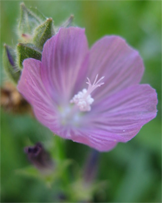 The dwarf checkerbloom is a subspecies of the sidalcea malviflora that is extremely rare, endemic to two known locations in the San Bernardino Mountains.
The dwarf checkerbloom is a subspecies of the sidalcea malviflora that is extremely rare, endemic to two known locations in the San Bernardino Mountains.
This flowering plant’s scientific name is sidalcea malviflora ssp. Dolosa. It has a second common name, the deceitful checker mallow.
A dicot, the checkerbloom is a perennial with a small cluster of leaves at its base and a two to three foot spike of 1 inch deep pink flowers. The stems are somewhat lax as the plant grows in perennial grass thickets in seasonal springs. It is showy in its own delicate way. It grows in partial shade to full sun. In nurseries, it remains visible in the ground when isolated but is hard to find in grassy thickets as it retains is a 4-inch clump of leaves. This may be a survival trait to protect itself from deer, which find it to be tasty. It will survive well in winter deluges but needs little water in the summer. In the wild it grows with stipa cernua, stipa pulchera and muhlenbergia, and coastal sage scrub within a mixed evergreen forest, open pine forests, shadscale scrub and central oak woodland at elevations from 4,500 feet to 7,000 feet. It occurs usually in wetlands, and occasionally in non-wetlands
It sports bladed leaves. Its flower is a calyx, sparsely stellate-puberulent, with simple long hairs. Its foliage color is green and type is stressdeciduous. Sidalcea malvaeflora’s flower color is purplish.
It also coexists with horkelia species and syrinchium bellum. Transplanted, it can flourish in granitic soils, to serpentine, edges of beach sand to heavy clay.
It is much like Sidalcea neomexicana, but has rhizome-like stems present, a rougher fruit, and stems that are more leafy. It strongly resembles, and is possibly a close relative to, Sidalcea reptans.
Transplanted, Sidalcea malvaeflora is great for a butterfly garden.
From: http://ucjeps.berkeley.edu, Wikipedia, https://www.calflora.org
SBCSentinel
News of note from around the largest county in the lower 48 states.
